Lighting really shapes your home’s vibe, doesn’t it? A thoughtful lighting scheme does more than just make things brighter—it sets the mood, draws attention to features, and makes every room easier to use.
Remember to repin your favorite images!
If you stick to just one light source, rooms usually end up feeling flat or a bit lifeless.

A successful layered lighting plan blends ambient, task, and accent lighting to add depth, dimension, and flexibility to your space. With this method, you can shift the mood of a room throughout the day or for different activities.
Bright task lighting is perfect for cooking or reading. Softer ambient lighting helps you wind down in the evening.
When you create zones with different lighting types, you add both style and practicality. Mixing things up with recessed lights, pendants, sconces, and table lamps makes your lighting plan more interesting and useful.
The right mix means you control the atmosphere and get the most out of every room.
Understanding Layered Lighting
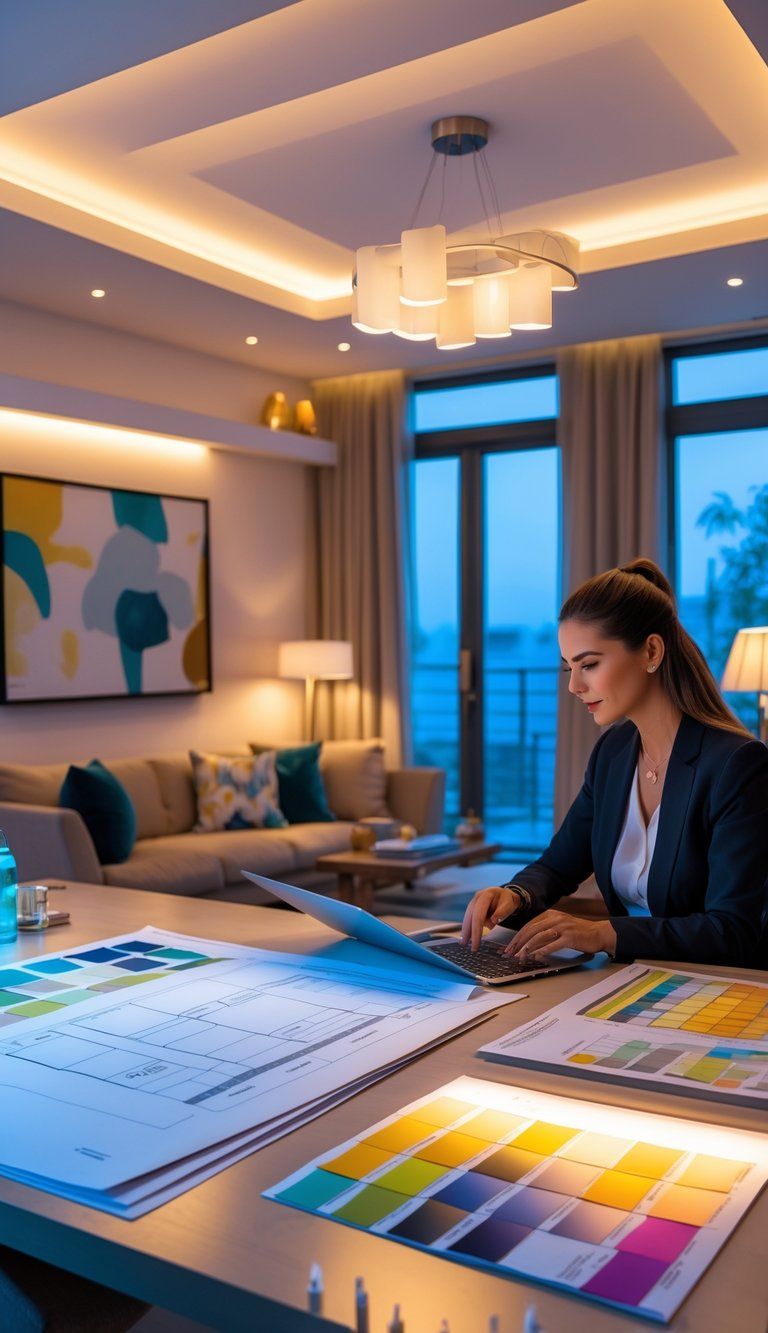
Layered lighting brings ordinary spaces to life by combining different light sources for depth, function, and mood. When you design your lighting thoughtfully, you hit both the practical and the pretty.
The Principles of Light Layering
You layer light by placing multiple sources at different heights and brightness levels. This approach keeps things visually interesting and makes sure you can see what you’re doing.
Balance really matters. You want to avoid harsh shadows or blinding spots, so spread the light around. Notice how natural light changes in your space as the day goes on.
Flexibility is another biggie. Your lighting should adapt to whatever you’re up to. Dimmers help you tweak the brightness when you need to.
Think of your lighting in layers. Every layer has its job, but they all work together for a complete look.
Key Lighting Types and Definitions
Ambient Lighting: This is your main source of light—kind of like a base layer. You get it from ceiling fixtures, recessed lights, or just daylight from windows.
Task Lighting: These lights help you get stuff done. Think desk lamps, under-cabinet lights, or reading lamps.
Accent Lighting: Use these to show off your favorite features—maybe a painting or an architectural detail. Wall sconces, track lights, and picture lights make things pop.
Decorative Lighting: Sometimes the fixture itself is the star. Chandeliers, pendants, and table lamps can add style while still lighting the room.
Each type has a role, and together they give you a complete lighting setup.
Benefits of a Multi-Layered Approach
Layered lighting gives you options. You can make a room bright and lively for daytime, then switch to something softer at night.
It makes life easier, too. With the right task lighting, cooking, reading, or working feels less of a strain on your eyes.
Layering adds visual interest. It highlights textures and features you might not even notice otherwise.
You’ll probably save energy, too. You don’t have to blast the whole room with overhead lights—just use what you need, where you need it.
Your space feels ready for anything, whether it’s a quiet night in or a big get-together.
Core Components of a Layered Lighting Plan
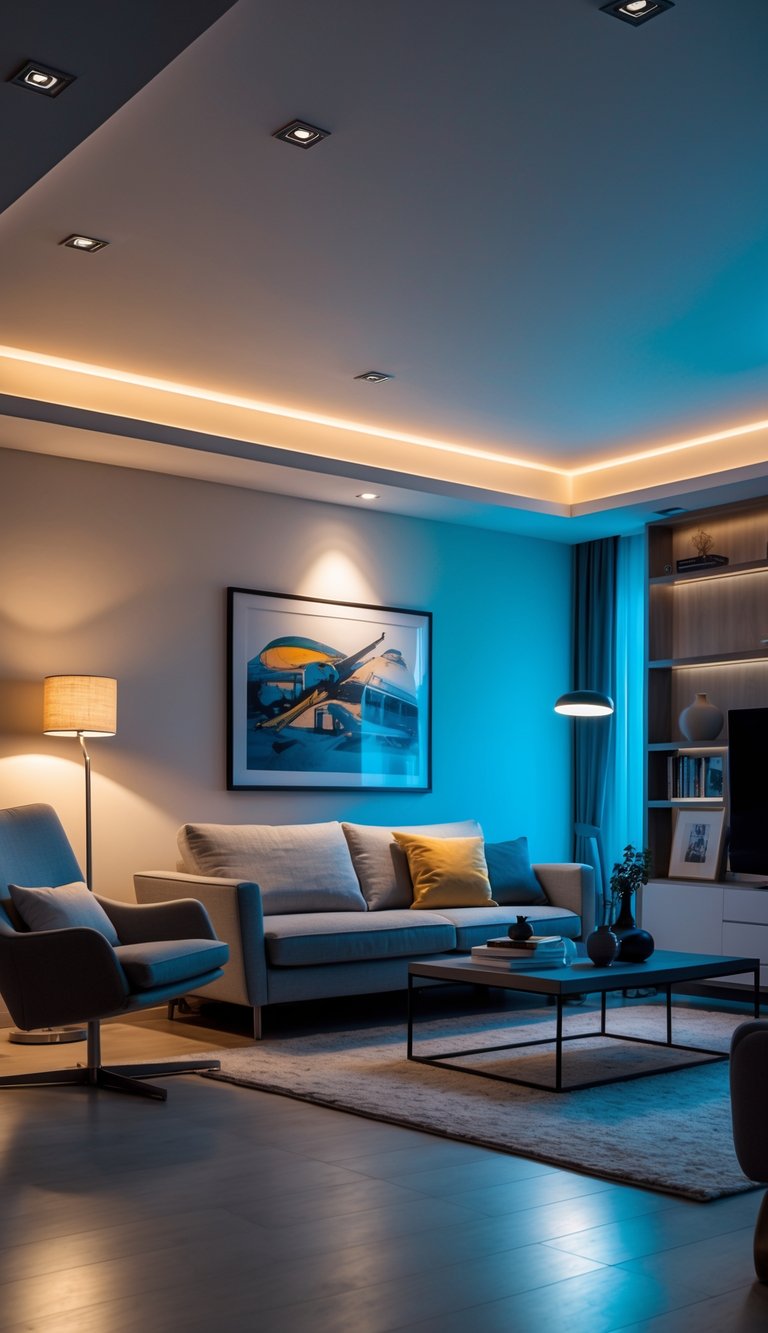
A good layered lighting plan mixes three main elements. Each one does something different, but together, they make your space work and feel just right.
Ambient Lighting Fundamentals
Ambient lighting is your base layer. It fills the room so you can move around safely. Think of it as the “primer” for everything else.
Ceiling fixtures like flush mounts, chandeliers, and recessed lights all provide solid ambient light. In bigger rooms, spread out recessed lights to keep shadows away.
Natural light matters, too! Use your windows during the day to save energy. When picking fixtures, go for soft, diffused light that doesn’t create harsh spots.
Keep the brightness comfortable—not too bright, not too dim. Dimmers make it easy to adjust the mood.
Task Lighting Applications
Task lighting shines where you need it most for specific activities. It keeps your eyes from working too hard.
In kitchens, under-cabinet lights brighten up counters for chopping and prepping. Pendant lights over islands target the work zone.
Home offices need adjustable desk lamps that light up your work without causing glare. Place them to the side, not directly over your screen.
In bathrooms, put vanity lights at eye level on both sides of the mirror to avoid weird shadows. For reading nooks, a floor lamp behind your chair works wonders.
Task lighting should be brighter than your ambient lights, but only in small areas.
Accent Lighting Strategies
Accent lighting brings a little drama. It draws the eye to features you want people to notice.
Mount picture lights above your art to make it stand out. Track lighting lets you move and aim spotlights as your decor changes.
For real impact, make accent lights at least three times brighter than your ambient lighting. That way, the features you highlight really pop.
Wall sconces can throw light up or down, adding texture to your walls. LED strips in shelves show off collections without crowding the space.
Colored LEDs can add a fun vibe in entertainment spaces. Outdoors, accent lighting makes landscaping shine and lets you enjoy your yard after sunset.
Selecting Lighting Fixtures for Each Layer
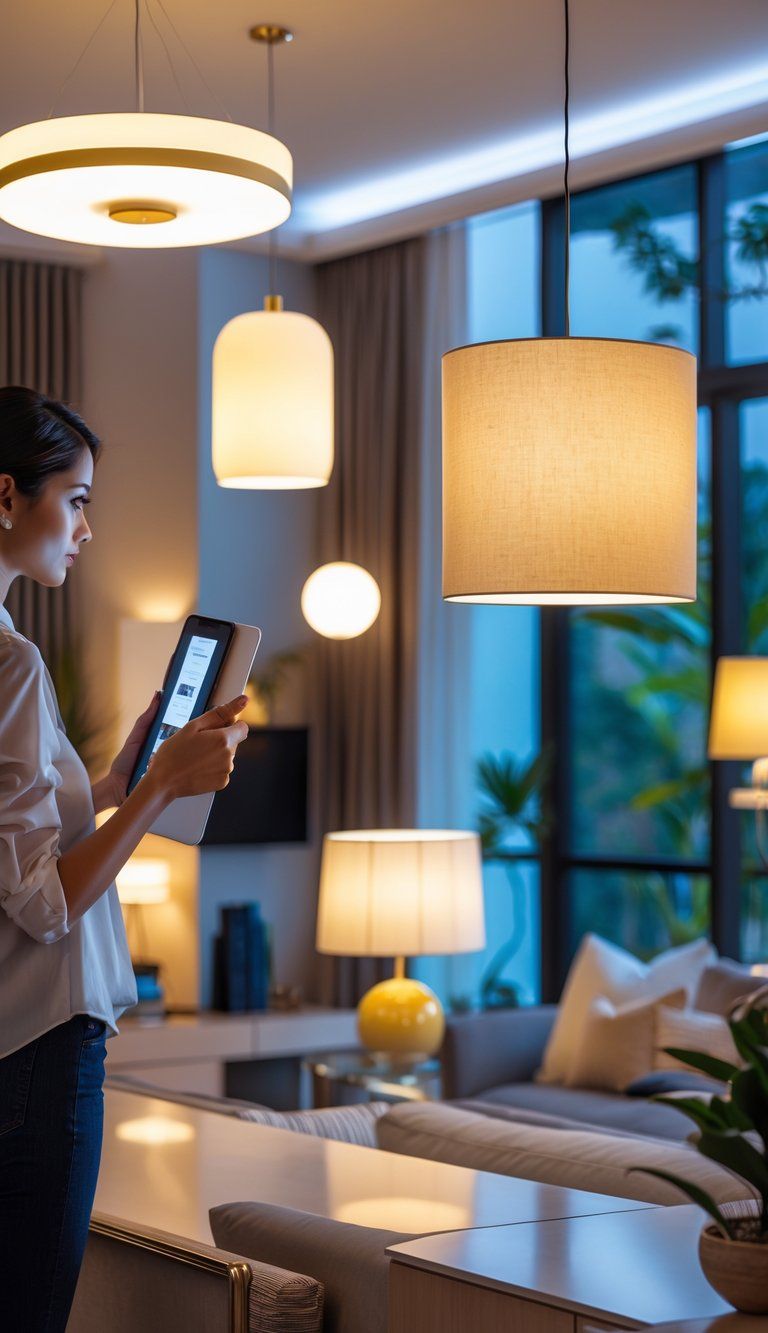
Choosing the right fixtures really changes the game. Each lighting layer needs its own kinds of fixtures, and together, they make your plan balanced and practical.
Choosing Ambient Lighting Fixtures
Ambient lighting sets the stage. For big rooms, ceiling-mounted fixtures like chandeliers or flush mounts spread light all over. Chandeliers look great in dining rooms or foyers, while flush mounts work when ceilings are low.
Recessed lighting gives a clean, modern look and doesn’t fight your decor. If you use these, space them 4-6 feet apart for even light. Lots of folks like dimmable LED recessed lights for saving energy and flexibility.
Pendant lights can work as ambient lighting if you hang several or pick ones with shades that let light spread. In living rooms, ceiling fans with lights pull double duty.
For high ceilings, semi-flush mounts are a good middle ground between flush fixtures and chandeliers.
Optimal Task Lighting Fixtures
Task lighting puts the spotlight where you need it. In kitchens, under-cabinet LEDs make countertops safer and easier to use.
Desk lamps and reading lamps are must-haves for workspaces or cozy corners. Adjustable arms let you point light exactly where you want. Keep the bottom of the lampshade at eye level to cut down on glare.
For bathroom vanities, wall sconces on both sides of the mirror at eye level keep your face evenly lit. In craft rooms, track lighting lets you aim light at whatever project you’re working on.
Table lamps with opaque shades focus light downward for tasks and add to the room’s overall glow. For reading in bed, articulating wall-mounted lamps save space and let you adjust the light.
Accent and Decorative Lighting Options
Accent lighting brings out your home’s best features. Picture lights above artwork give you that gallery feel. Pick ones that light the art without making glass glare.
Wall sconces can wash light up or down, adding texture and a touch of drama. Try them in hallways, next to fireplaces, or in dining rooms for a cozy glow.
LED strip lights are super flexible. Put them behind entertainment centers, under cabinets, or along stairs for both safety and style. You can trim these to fit almost any space.
Decorative lighting is like jewelry for your room. Statement chandeliers, funky pendants, and unique table lamps show off your personality while still being useful.
Outdoors, landscape lighting makes your yard look good at night and adds some security.
Designing Your Lighting Plan
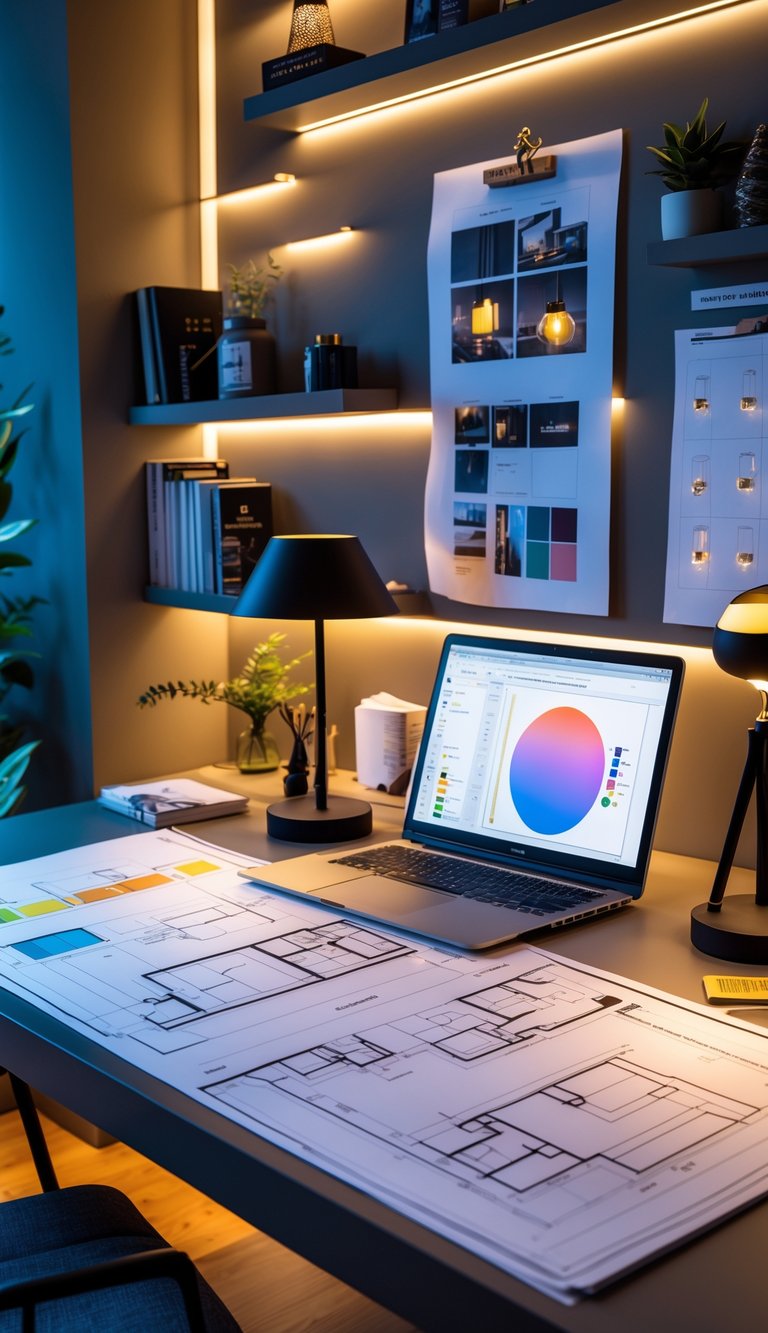
A great lighting plan takes a little planning and a good look at your space. You want to balance how things work with how they look—and sidestep the usual lighting mistakes.
Room Assessment and Needs Analysis
Start by figuring out what you do in each room. Every space needs something different. Kitchens need bright lights for cooking, while living rooms do better with options you can layer and adjust.
Measure your space and check ceiling heights, window spots, and where your outlets are. All of this shapes where you can put fixtures.
Watch how sunlight moves through the room over the day. South-facing rooms get more sun, so you might need less artificial light there.
List out what happens in each space. Reading? You’ll want focused light. Entertaining? Adjustable lighting is key.
Take note of cool architectural details. Lighting can help them stand out instead of fading into the background.
Strategic Placement for Maximum Impact
Place ambient lighting so it fills the whole room evenly. Recessed fixtures, chandeliers, or pendants all work for this.
Put task lighting right where you need it. Under-cabinet lights in the kitchen, desk lamps in your office, or reading lights by your favorite chair make a big difference.
Accent lighting draws the eye to something special—artwork, a textured wall, or a great piece of furniture. Use wall sconces, track lights, or spotlights to highlight these.
Pay attention to fixture height. Hang pendants 30-36 inches above tables. Wall sconces usually go 60-72 inches from the floor.
Add dimmers to change up the mood whenever you want. They’re a simple way to make your lighting work for any occasion.
Avoiding Over-Lighting and Under-Lighting
Getting the balance right is tricky. Too many lights make a room feel harsh and full of glare. Not enough, and things look gloomy.
Figure out the right amount of light by multiplying your room’s square footage by 1.5 to get the total wattage you need. Spread that out with several fixtures for even coverage.
Pick bulbs with the right brightness and color. Warm white (2700-3000K) feels cozy, while cool white (3500-4100K) works better for tasks.
Surfaces matter. Dark walls soak up light, so you’ll need more. Lighter colors and mirrors bounce light around, so you can get away with less.
Test your setup at different times. What works at noon might not feel right after sunset.
Start simple. It’s easier to add more lights than to take them away if things feel too bright.
Optimizing Light Quality and Output

Picking the right bulbs and making sure you have the right brightness really sets the stage for great layered lighting. When you get these details right, you can totally transform your rooms.
Understanding Bulbs and Light Sources
Different light sources totally change the mood and feel of your home. LED bulbs give you energy efficiency and last ages—sometimes 25 times longer than those old-school incandescent bulbs.
Most people find LEDs ideal for just about every home lighting need.
Incandescent bulbs put out that classic, warm light, but they eat up more energy. Halogen bulbs, on the other hand, give you crisp, white light that’s perfect for kitchens or offices where you need to see what you’re doing.
Light color really matters. Color temperature shows up in Kelvins (K):
- 2700-3000K: Warm white (cozy, relaxing)
- 3500-4100K: Cool white (energizing, good for workspaces)
- 5000-6500K: Daylight (sharpest, most alert feeling)
Go for warm lights in living rooms and bedrooms, and use cooler ones in workspaces. If you’re into gadgets, smart bulbs let you tweak color temperature through the day to match natural light cycles.
Managing Brightness, Lumens, and Intensity
We measure brightness in lumens, not watts. For a living room, you’ll want about 1,500-3,000 lumens total.
Kitchens and workspaces need more punch—think 4,000-8,000 lumens.
Dimmers are a must for controlling light intensity. You can dial the brightness up or down depending on what you’re doing or the time of day.
Put dimmers on your main lights for more flexibility.
Light shades and diffusers shape how light moves through your room. Opaque shades push light up or down, while translucent ones soften everything out.
Layer your lighting by purpose:
- Ambient: 1,500-3,000 lumens (general room lighting)
- Task: 450-900 lumens per area (reading, cooking)
- Accent: 75-300 lumens (highlighting artwork or features)
When you balance these levels, your room feels more dynamic and interesting.
Controlling Lighting for Flexibility
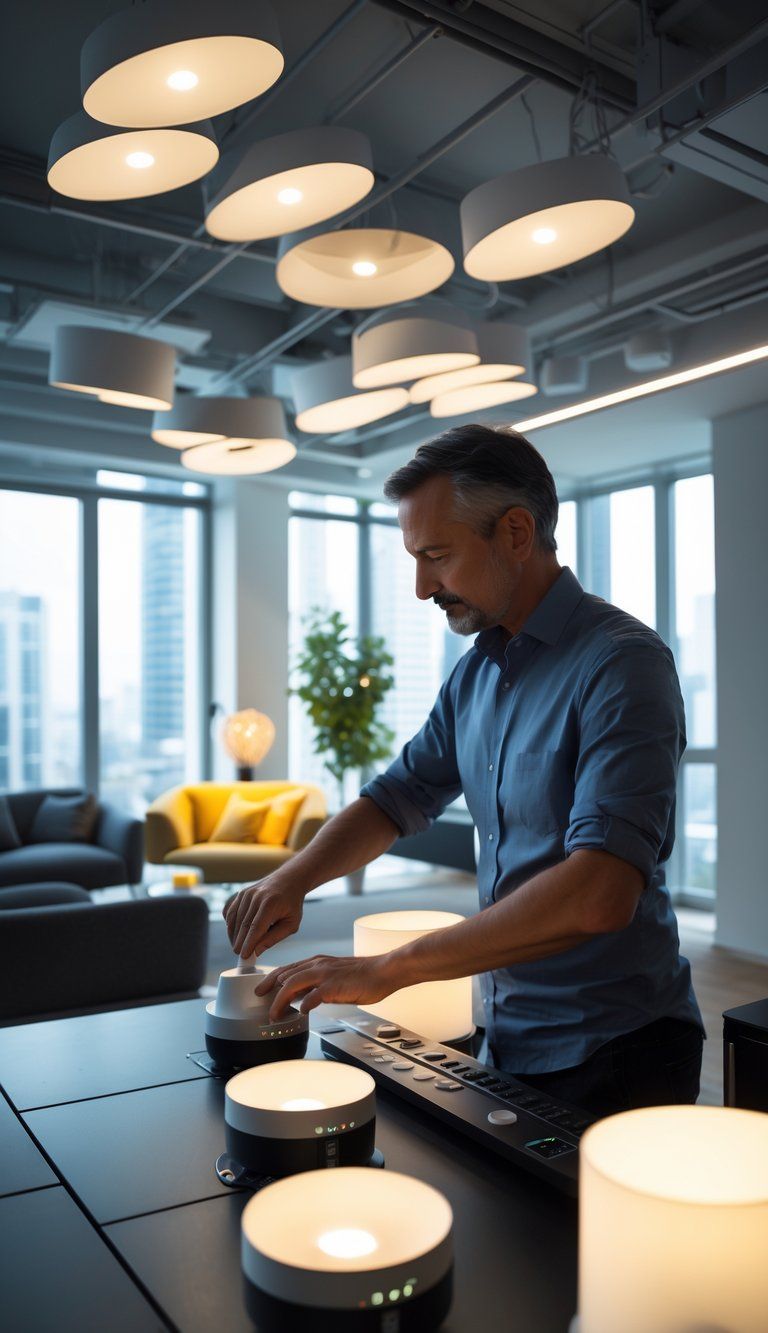
A good lighting plan gives you control so you can shift light levels for different moods or times of day. The right controls honestly change how you experience your space.
Incorporating Dimmers and Light Controls
Dimmer switches are a cheap and easy way to boost flexibility. Put them on overhead fixtures and you can take the brightness from full blast down to a soft glow.
That way, you set the mood for any occasion.
Zone controls help you handle several lights from one spot. Divide your room into zones based on how you use it—maybe one for dining, another for conversation, and a third for reading.
Three-way switches work great in rooms with more than one entrance. They let you turn lights on or off from different spots, so you don’t have to stumble through the dark.
Rotary or slide dimmers are easy to use and make quick adjustments simple. Modern dimmers often come with presets, so you can jump right to your favorite setting.
Smart Lighting Technology Integration
Smart lighting tech gives you even more control. These systems connect to your home network, so you can manage lights from your phone, tablet, or even with your voice.
Motion sensors flip lights on when you walk in and off when you leave, saving energy and hassle. Light sensors tweak brightness based on natural light, keeping things steady all day.
Many smart systems let you schedule lights to gradually brighten in the morning or fade out at night, which can help your sleep routine.
Scene settings let you save your favorite combos. With one tap, you can switch from “cooking” mode with bright light to “dinner” mode with something softer.
Try to find systems that work with other smart home stuff—like thermostats or security—for a more connected feel.
Enhancing Ambiance and Mood

Lighting totally changes a room’s vibe. When you mix up color temperatures and place lights thoughtfully, your space adapts to anything—work, play, or just relaxing.
Balancing Color Temperature and Light Color
Color temperature really sets the mood. Warm lights (2700-3000K) make living rooms and bedrooms feel cozy and chill.
Cooler lights (4000-5000K) keep you alert in kitchens or offices.
Try using both in the same space. Warmer lights help you unwind at night, while cooler ones get you focused during the day.
Many modern fixtures let you change colors as you like.
Light color can totally transform a room. Check out these options:
- Colored bulbs for accent lighting
- Color filters on fixtures you already have
- RGB LED strips behind furniture for a bold effect
A dimmer switch is a simple way to shift the mood—no need to swap out fixtures.
Creating Depth and Dimension with Lighting
Layered lighting keeps a room from feeling flat. Start with ambient lighting—ceiling fixtures or recessed lights—to cover the basics.
Add task lighting where you need it:
- Reading lamps next to chairs
- Under-cabinet lights in the kitchen
- Desk lamps for work zones
Accent lighting comes last, highlighting features or artwork. Wall sconces, picture lights, and uplights add those cool shadows and highlights.
Mix up heights, too. Floor lamps, table lamps, and ceiling lights at different levels keep things interesting and avoid that “one big light” look.
Integrating Natural and Artificial Light Sources
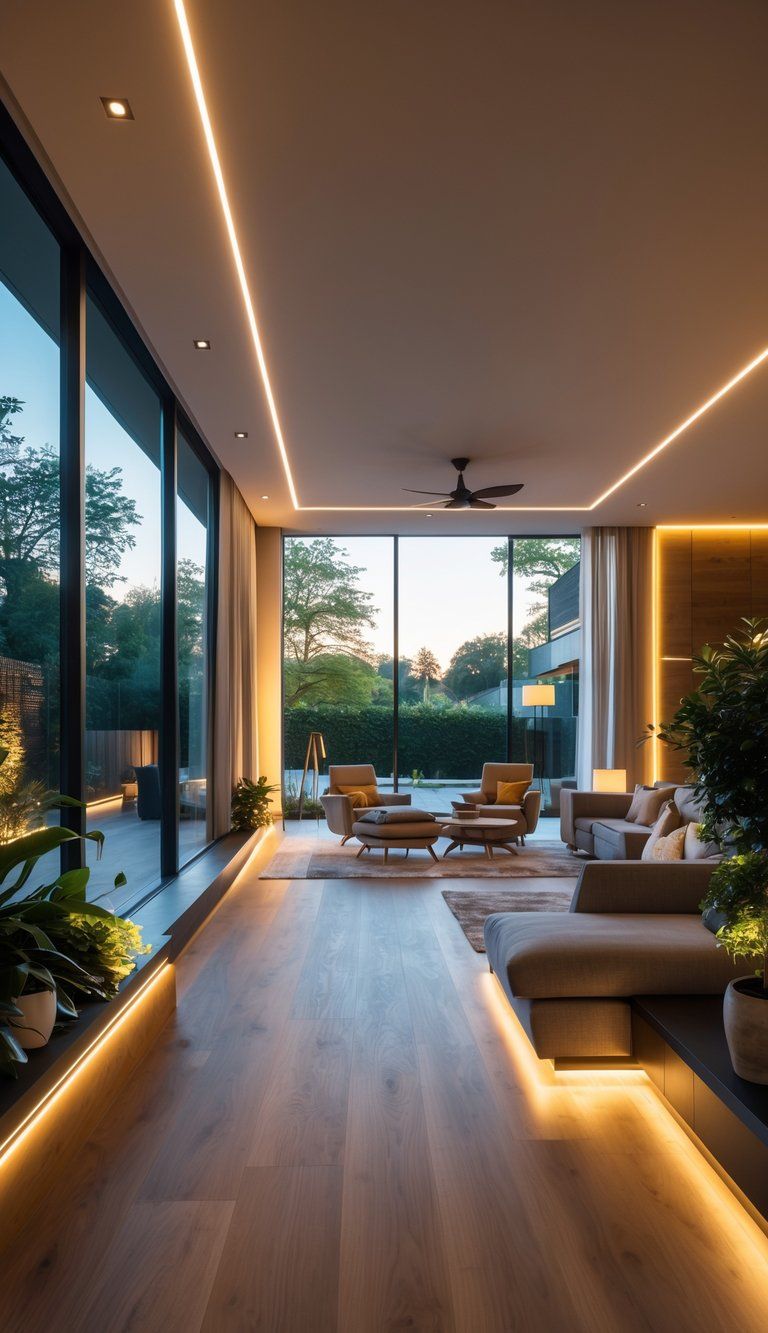
A great lighting plan blends natural and artificial light for spaces that feel balanced and inviting. Doing this saves energy and just looks better, honestly.
Utilizing Daylight and Natural Sunlight
Natural light is a game changer. It cuts down your energy bills and lifts your mood.
Arrange your furniture to catch light from windows and skylights. South-facing windows give steady light all day, while east-facing ones serve up bright mornings.
Try light-colored window treatments you can adjust as the sun moves. Sheer curtains soften harsh sunlight but keep things bright.
If your space is short on windows, place mirrors opposite them to bounce daylight around.
Light shelves are clever, too. Install them above eye level to reflect daylight deeper into the room.
Solar tubes and skylights can bring natural light into spots that don’t have windows.
Combining Natural and Artificial Lighting Elements
Let artificial lighting work with natural light, not against it. Add dimmers so you can adjust brightness as daylight changes.
Some layering tricks:
- Wall sconces fill in where sunlight fades
- Under-cabinet lights fight kitchen shadows
- Floor lamps brighten up seating areas that windows miss
Smart lighting systems can adjust automatically based on the daylight. Sensors keep your space consistently lit and save energy.
Pick bulbs with color temperatures that play nice with natural light. Cooler (4000-5000K) is good for day, warmer (2700-3000K) for cozy evenings.
Let both types of light work together so your rooms always feel just right, no matter what time it is.
Energy Efficiency and Sustainability in Layered Lighting
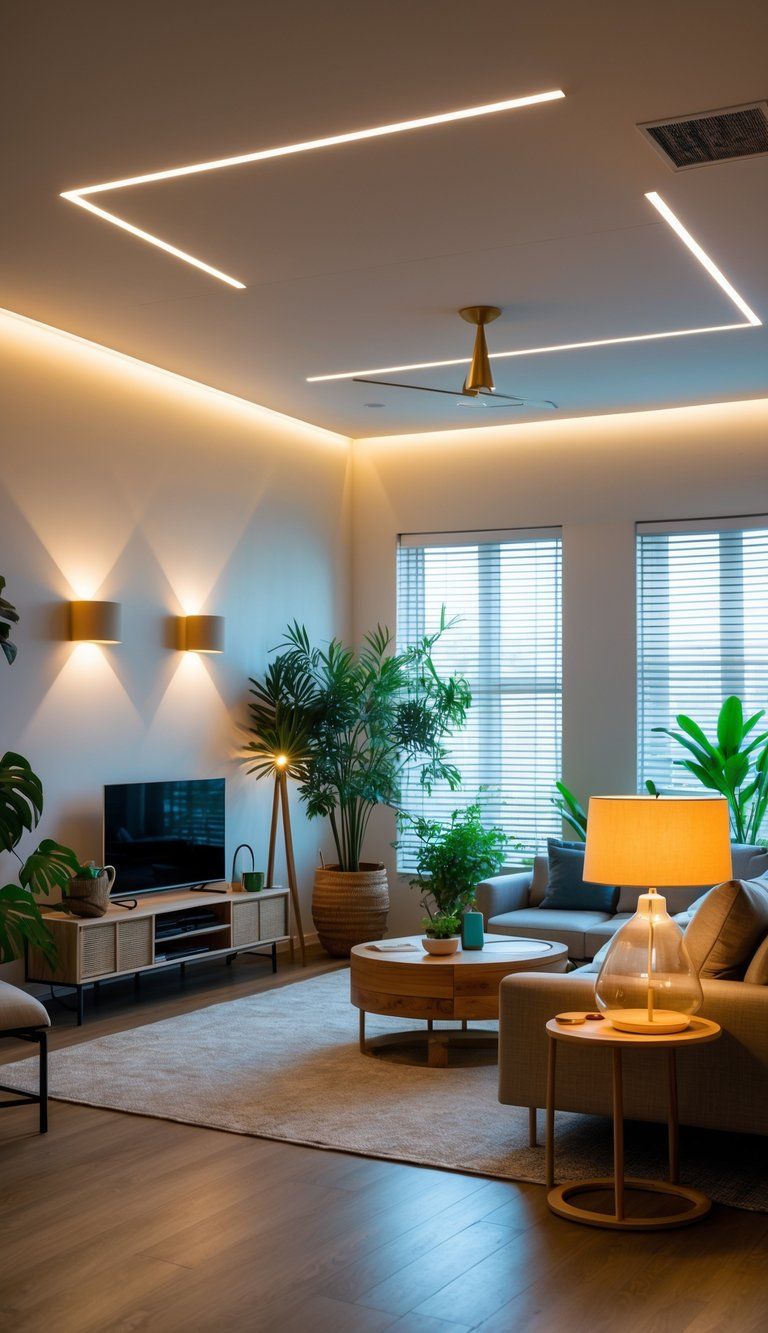
Layered lighting can look amazing and still be energy smart. The right choices save you money and keep things comfortable.
Selecting Energy-Efficient Bulbs and Fixtures
LED bulbs really are the best for energy-efficient lighting. They use up to 75% less energy than incandescents and last way longer.
When you shop for fixtures, look for that ENERGY STAR label—it means the product meets strict efficiency standards.
Try these LED options for each layer:
- Ambient lighting: LED recessed cans or flush mounts
- Task lighting: LED under-cabinet strips or desk lamps
- Accent lighting: LED picture lights or track lighting
Color temperature is important, too. For living rooms, warm white LEDs (2700-3000K) feel like traditional bulbs. For work areas, cooler whites (3500-4000K) help you focus and reduce eye strain.
Maximizing Efficiency Without Sacrificing Quality
Smart controls really help you strike that tricky balance between efficiency and impact. Just swapping in dimmer switches can cut your energy use by 4-9%. Plus, your bulbs last longer—always a nice bonus.
Want to get even more out of your setup? Try motion sensors in spots you barely use. Timers work well for outdoor or security lights. You can even let a smart home system handle lighting based on when you’re home or the time of day.
If you layer your lighting with these controls, you only use what you actually need. Think about it—a living room probably uses just 30% of its lighting most evenings. You’ll only crank it up all the way when you’re cleaning or having people over.
Let’s not forget natural light. Place mirrors to bounce daylight deeper into your rooms. Go with sheer curtains that let sunlight filter through instead of blocking it. That move alone can drop your need for daytime lighting by as much as 80% when the sun’s at its brightest.

